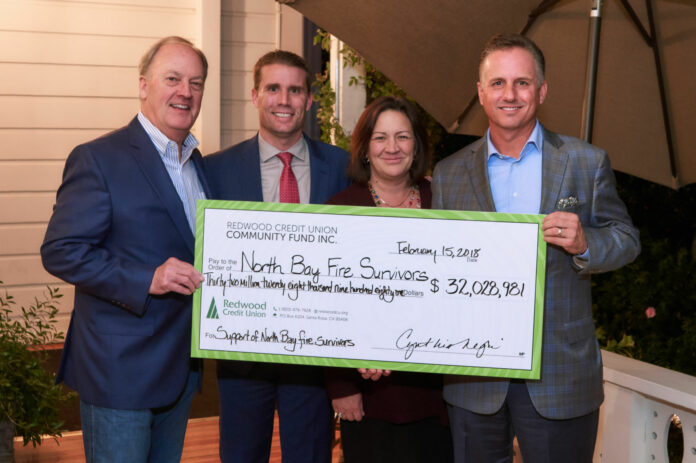Editor’s note: This story was generated from a SoCurious question as part of our public-powered newsroom series powered by the Hearken platform.
Correction: An older print version of this story in the Jan. 24 Tribune issue had incorrect data. This is the correct data and the data has since been updated online: The fund was launched after the fires on Oct. 9, not Oct. 5 and $20,498,854 went to individuals (first responders, students and individuals who lost their home or experienced economic hardships). Fund applicants were vetted by outside, independent organizations. Around 2,000 K-12 and college students benefited from a portion of the $20 million figure.
“Out of the money donated to the fund that Redwood Credit Union had, where, exactly, did all that money go? (How did it get down to families who were in need)?” – Anonymous
After receiving this question from a local who wishes to remain anonymous, we set out to interview the folks behind the North Bay Fire Relief Fund, Senior Vice President of Community and Government Relations Matt Martin and Communications and Public Relations Manager Tracy Weitzenberg. We also asked for stories highlighting how individuals used fire relief funds to get back on their feet.
In the span of 16 weeks, $32 million was raised, portions of which were distributed via checks, gift cards and Visa cards to families, first responders, students, nonprofits and businesses.
The fund was organized as a dollar donor system. Redwood Credit Union (RCU) paid all administrative costs of the fund so 100 percent of donations went to those in need and according to Martin, around 70 percent of all dollars donated came from outside of the four impacted counties.
“People were pouring out from everywhere wanting to help. Every state in the union was represented and 23 other countries were donors,” Martin said. “Two weeks into it I got a call from Sweden saying it (the fund) doesn’t take the currency but they still wanted to donate.”
The fund, which was launched shortly after the fires on Oct. 9, was established in conjunction with California State Sen. Mike McGuire and The Press Democrat and from start to finish, 41,000 donors participated.
In order to determine who would be the main recipients of the funds, RCU focused on creating support for immediate aid.
For fire survivors, RCU partnered with nonprofits with experience in receiving and vetting applications for assistance. United Way of the Wine Country, La Luz, North Coast Opportunities and the Center for Volunteer and Nonprofit Leadership all provided resources for helping to vet and process applications.
For the nonprofits, an independent grants committee comprised of local leaders from fire-impacted counties worked to vet grantee applicants.
“We balanced providing immediate fire relief for survivors along with a careful vetting process managed by our nonprofit partners,” Weitzenberg said. “The size and scope of this disaster made this a challenging task, but we knew we had the right organizations well versed in these procedures.”
Martin said nearly $20 million went directly to first responders, students, individuals who either lost their homes or experienced an economic hardship due to the fires.
2,253 K-12 and college students who lost books and supplies also received a chunk of the change.
Funds were given out in the form of gift cards so students could choose their own items.
A total of $9.59 million via grants went to support 56 nonprofits providing services to fire survivors.
“It was important to help bridge that gap and help them get from point A to point B to (get) people clothes, food, financial assistance, mental health support, security and more,” Martin said of the grants.
One million dollars was provided in an effort to help small businesses affected by the fires. Loft Salon in northern Santa Rosa was just one business that lost its building, supplies and all of its equipment.
With the provided funds, the salon was able to get new equipment for all 17 stylists and re-launched its business.
A total of 195 Sonoma County businesses were granted funds and a remaining four are still in the fund application phase.
This story’s anonymous questioner said she wondered how funds got to people who needed it the most.
Weitzenberg shared several stories of how nonprofits, especially mental well-being organizations, used the funds to make a difference.
“We’re hearing from nonprofits that the services they are able to provide with funding from the North Bay Fire Relief Fund are making a real difference,” Weitzenberg said. “We heard a story of a 5-year-old girl who lost everything in the fire and her traumatic stress manifested itself into stomach aches, sleeplessness, nightmares, uncontrollable crying and separation anxiety. She was able to receive free therapy sessions through one of our grantees.”
The girl is able to sleep again and her nightmares and stomachs have significantly decreased.
Another fund grantee was able to provide housing assistance to a family of three who lost their home and were living in their car. They were also able to receive financial assistance and gift cards to replace basic items.
“We also heard about an older gentleman that lost his livelihood. Without any family support, he became severely depressed. With the support of one of our grantees, he was able to find housing, a new job and regain home,” Weitzenberg stated.
Martin never expected to raise $32 million in funds.
“It was unprecedented,” he said. “We were absolutely blown away and humbled by the outpouring of compassion from friends and neighbors from all around the world. It just stunned us.”









